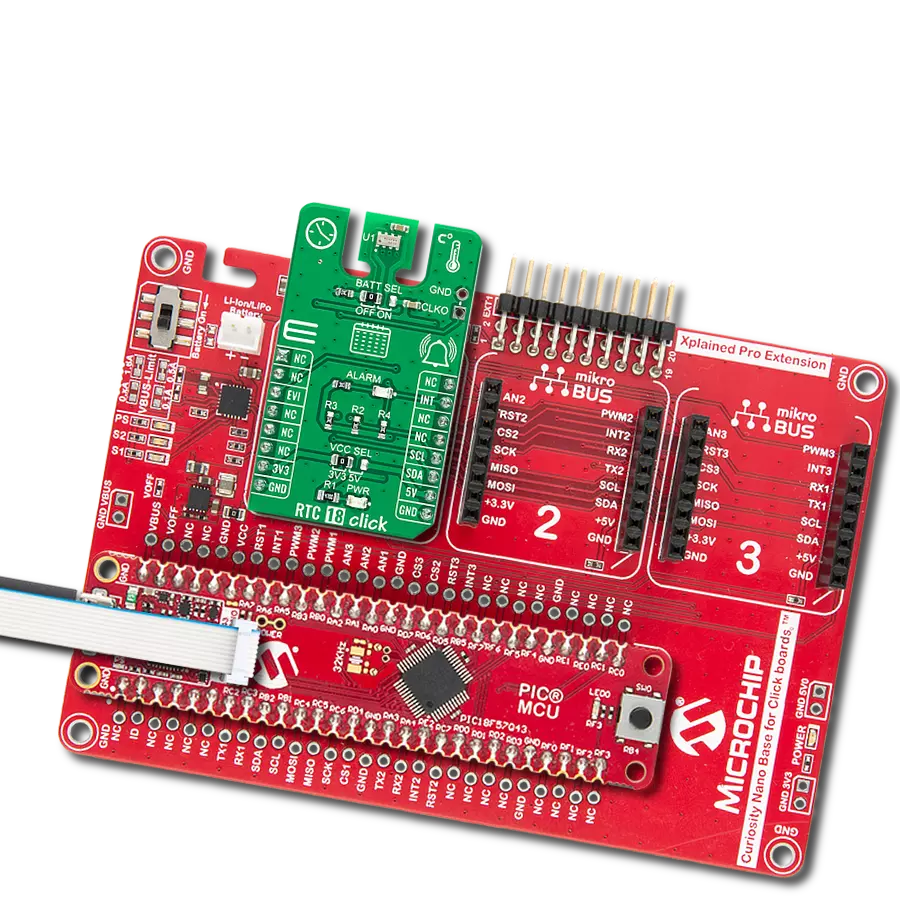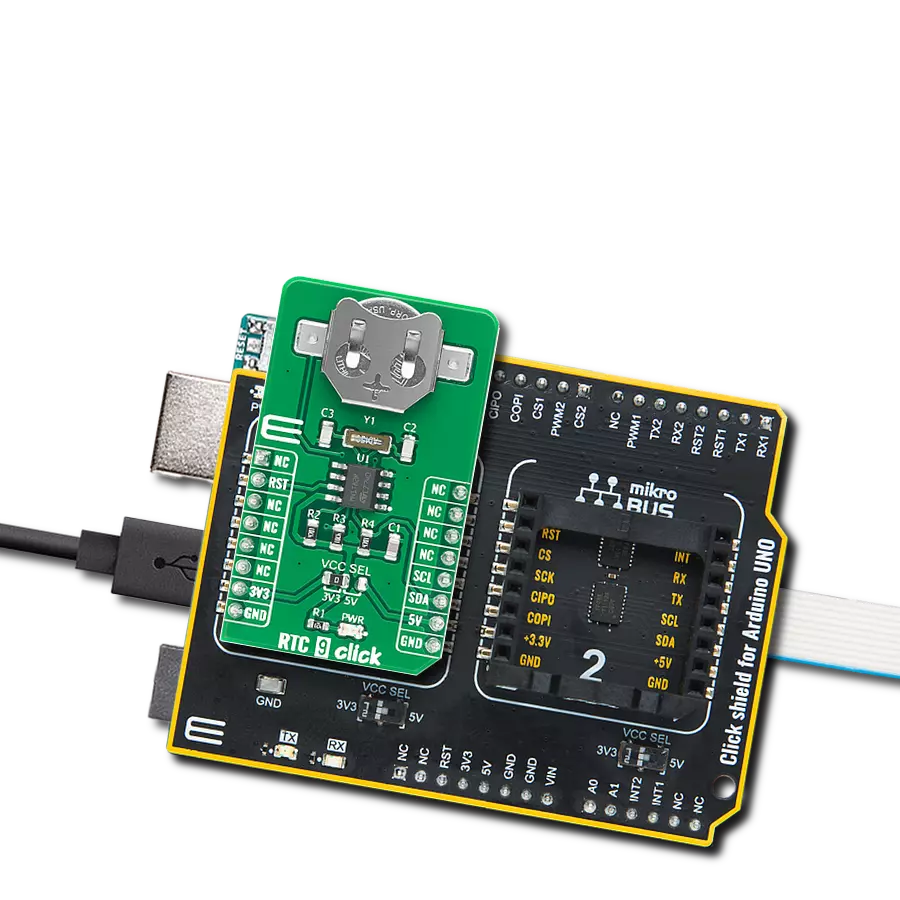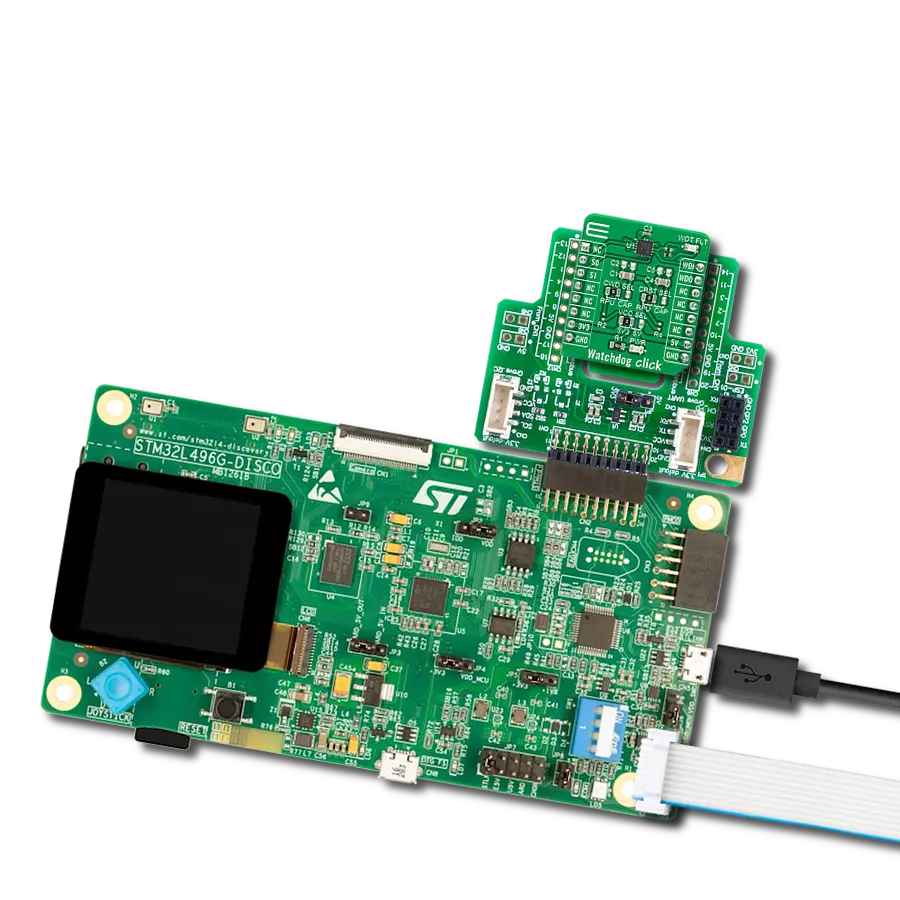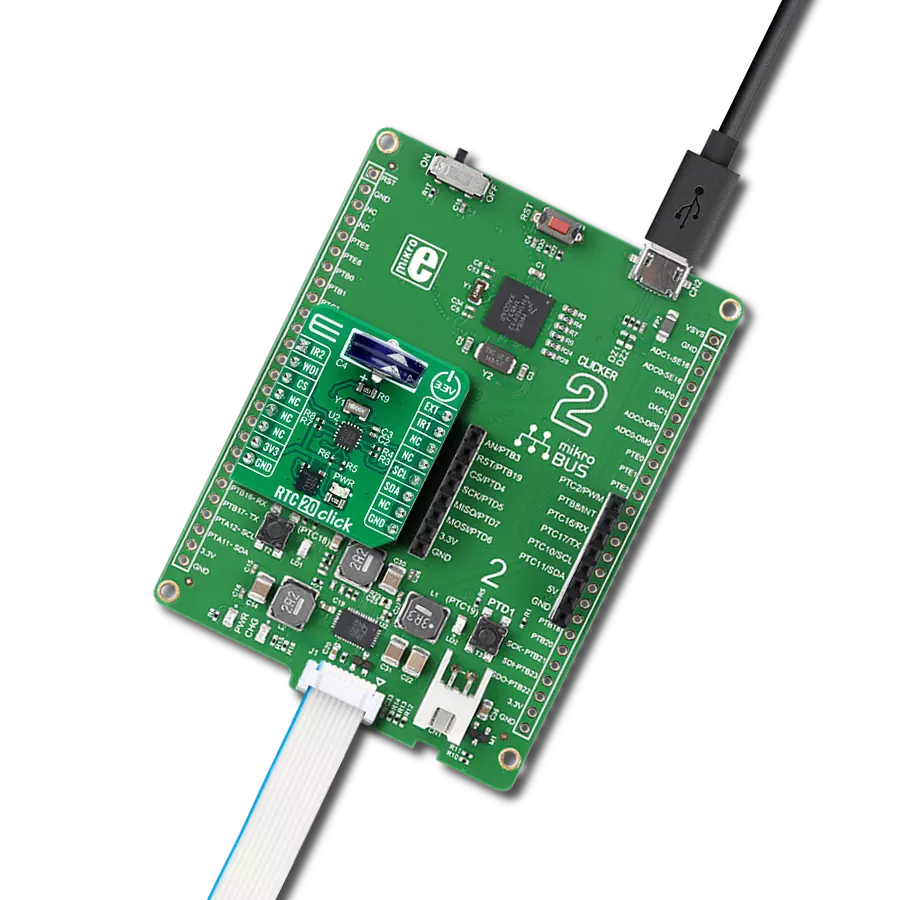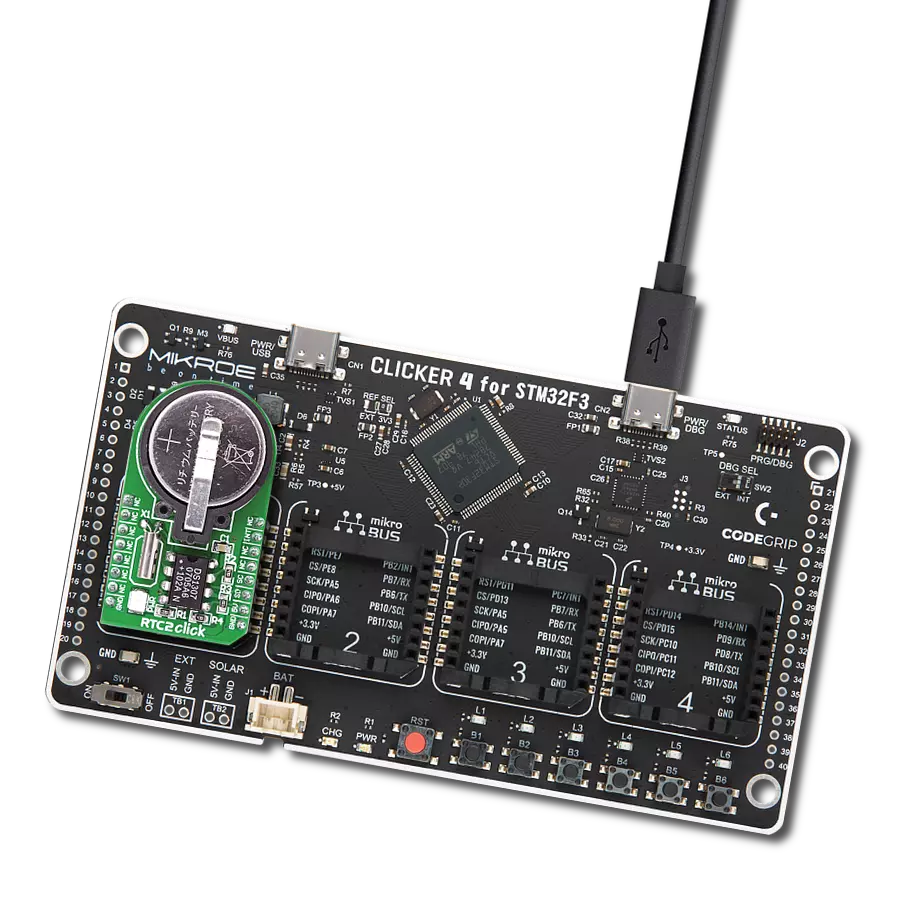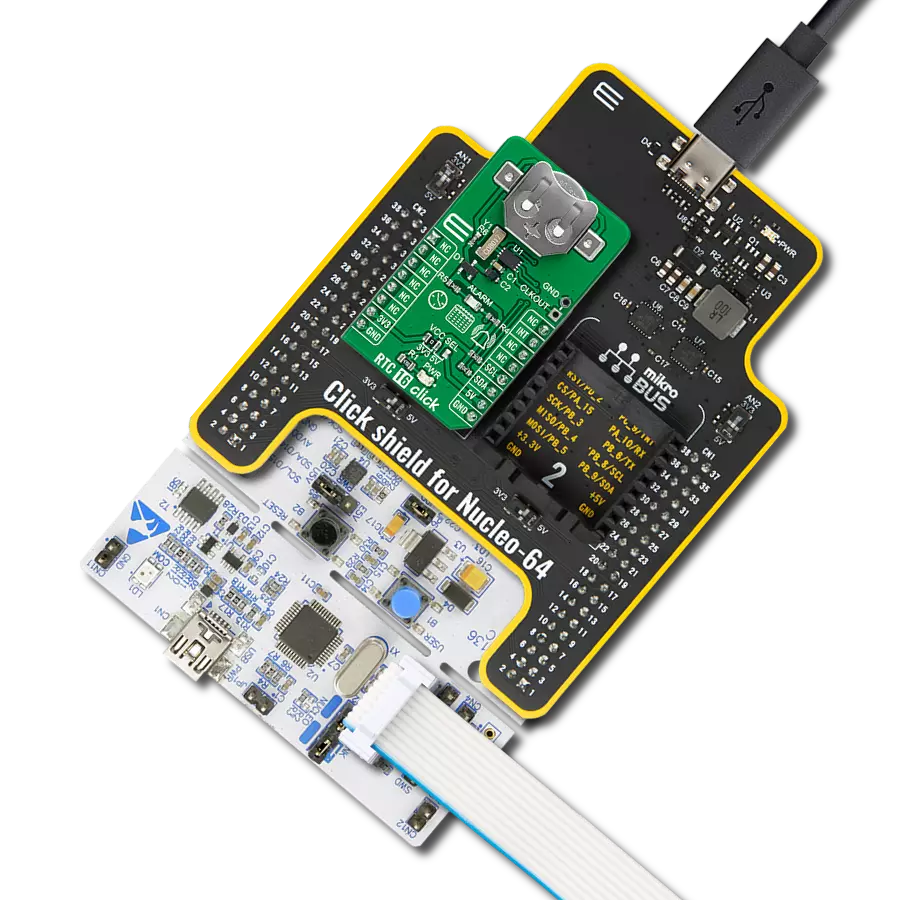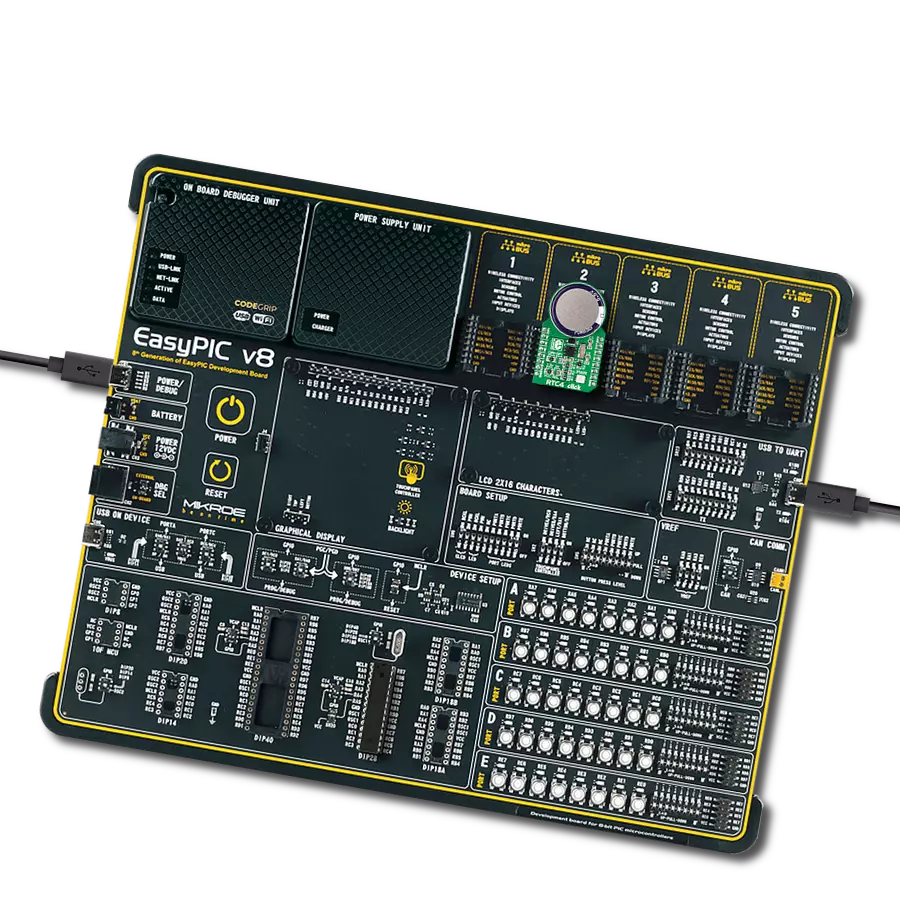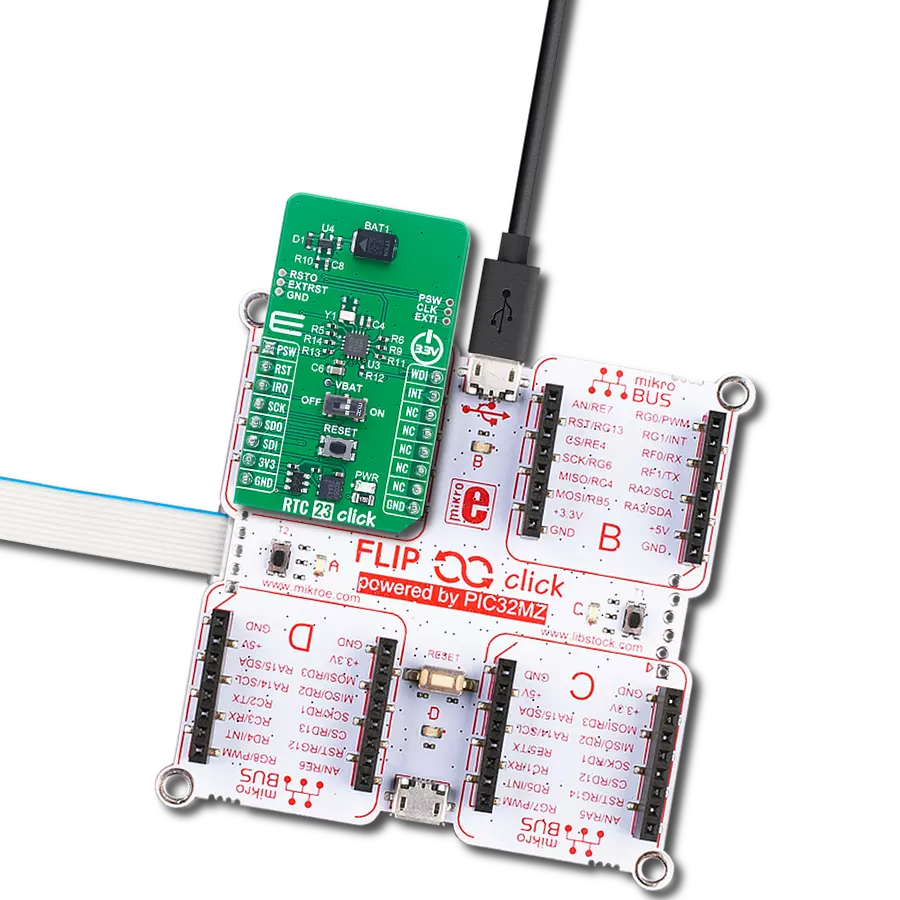Achieve seamless coordination and synchronization of events in your applications with our cutting-edge real-time clock solution
A
A
Hardware Overview
How does it work?
RTC 8 Click is based on the RV-3028-C7, an extreme low power real-time clock/calendar (RTC) module from Micro Crystal Switzerland. Thanks to its high integration level, this module provides high time accuracy, factory calibrated to 1 ppm, with a very low count of external components required. It has a full RTC function, offering programmable counters, alarms, and an interrupt engine with selectable event reporting sources. In addition to a standard clock output function, it also offers a 32-bit UNIX Time counter. The operational parameters are stored within the internal non-volatile memory (EEPROM) allowing their persistence in the event of the complete power failure. The small dimension of the RV-3028-C7 module itself, allow it to be used in very space-constrained applications, including wearables, medical equipment, and similar. In addition to the RV-3028-C7, RTC 8 click is equipped with the button cell battery holder compatible with the CR1225 battery. By utilizing an automatic backup switch, the IC is able to use an external battery power source when there is no power supply on its main power terminals, thus
allowing for uninterrupted operation. Draining as low as 40nA of current, it can be operated with the standard button cell battery almost indefinitely. In addition, a trickle charge system will replenish the battery power while the RV-3028-C7 is powered over the main power terminals (VDD, VSS). The voltage of the main power supply can range between 1.2V up to 5.5V. The RV-3028-C7 uses the I2C communication protocol for the communication with the host MCU. Besides the I2C bus lines, two additional pins are also available on the RV-3028-C7, allowing an interrupt to be reported to the host MCU, but also to capture an external event and marking it with an automatic timestamp. The user is able to set up standard clock and calendar functions (including seconds, minutes, hours, weekdays, date, months, years with leap year correction), as well as the interrupt functions for the periodic countdown timer, periodic time update, alarm, external event, automatic backup switchover and power on reset (POR) events. All these features are available when the module is operated over the backup power supply (battery). A group of configuration registers
is used to set up all the various working parameters of the device. To additionally prevent any unintentional changes of the internal registers, the RV-3028-C7 offers password protection of its configuration. If the password protection is set by an enable register in the non-volatile memory, each time the register configuration is attempted, the user will be required to enter the password first. Naturally, reading out the password registers will return 0 values; this register is write-only. Besides other functions, EEPROM memory holds the offset correction values. Offset correction is required for fine-tuning the internal 32.768 kHz XTAL, as well as for compensating the aging phenomenon. This Click board™ can operate with either 3.3V or 5V logic voltage levels selected via the VCC SEL jumper. This way, both 3.3V and 5V capable MCUs can use the communication lines properly. Also, this Click board™ comes equipped with a library containing easy-to-use functions and an example code that can be used as a reference for further development.
Features overview
Development board
Nucleo-64 with STM32G071RB MCU offers a cost-effective and adaptable platform for developers to explore new ideas and prototype their designs. This board harnesses the versatility of the STM32 microcontroller, enabling users to select the optimal balance of performance and power consumption for their projects. It accommodates the STM32 microcontroller in the LQFP64 package and includes essential components such as a user LED, which doubles as an ARDUINO® signal, alongside user and reset push-buttons, and a 32.768kHz crystal oscillator for precise timing operations. Designed with expansion and flexibility in mind, the Nucleo-64 board features an ARDUINO® Uno V3 expansion connector and ST morpho extension pin
headers, granting complete access to the STM32's I/Os for comprehensive project integration. Power supply options are adaptable, supporting ST-LINK USB VBUS or external power sources, ensuring adaptability in various development environments. The board also has an on-board ST-LINK debugger/programmer with USB re-enumeration capability, simplifying the programming and debugging process. Moreover, the board is designed to simplify advanced development with its external SMPS for efficient Vcore logic supply, support for USB Device full speed or USB SNK/UFP full speed, and built-in cryptographic features, enhancing both the power efficiency and security of projects. Additional connectivity is
provided through dedicated connectors for external SMPS experimentation, a USB connector for the ST-LINK, and a MIPI® debug connector, expanding the possibilities for hardware interfacing and experimentation. Developers will find extensive support through comprehensive free software libraries and examples, courtesy of the STM32Cube MCU Package. This, combined with compatibility with a wide array of Integrated Development Environments (IDEs), including IAR Embedded Workbench®, MDK-ARM, and STM32CubeIDE, ensures a smooth and efficient development experience, allowing users to fully leverage the capabilities of the Nucleo-64 board in their projects.
Microcontroller Overview
MCU Card / MCU
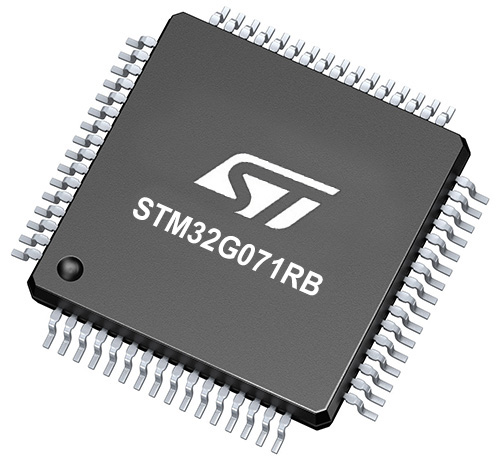
Architecture
ARM Cortex-M0
MCU Memory (KB)
128
Silicon Vendor
STMicroelectronics
Pin count
64
RAM (Bytes)
36864
You complete me!
Accessories
Click Shield for Nucleo-64 comes equipped with two proprietary mikroBUS™ sockets, allowing all the Click board™ devices to be interfaced with the STM32 Nucleo-64 board with no effort. This way, Mikroe allows its users to add any functionality from our ever-growing range of Click boards™, such as WiFi, GSM, GPS, Bluetooth, ZigBee, environmental sensors, LEDs, speech recognition, motor control, movement sensors, and many more. More than 1537 Click boards™, which can be stacked and integrated, are at your disposal. The STM32 Nucleo-64 boards are based on the microcontrollers in 64-pin packages, a 32-bit MCU with an ARM Cortex M4 processor operating at 84MHz, 512Kb Flash, and 96KB SRAM, divided into two regions where the top section represents the ST-Link/V2 debugger and programmer while the bottom section of the board is an actual development board. These boards are controlled and powered conveniently through a USB connection to program and efficiently debug the Nucleo-64 board out of the box, with an additional USB cable connected to the USB mini port on the board. Most of the STM32 microcontroller pins are brought to the IO pins on the left and right edge of the board, which are then connected to two existing mikroBUS™ sockets. This Click Shield also has several switches that perform functions such as selecting the logic levels of analog signals on mikroBUS™ sockets and selecting logic voltage levels of the mikroBUS™ sockets themselves. Besides, the user is offered the possibility of using any Click board™ with the help of existing bidirectional level-shifting voltage translators, regardless of whether the Click board™ operates at a 3.3V or 5V logic voltage level. Once you connect the STM32 Nucleo-64 board with our Click Shield for Nucleo-64, you can access hundreds of Click boards™, working with 3.3V or 5V logic voltage levels.
Used MCU Pins
mikroBUS™ mapper
Take a closer look
Click board™ Schematic

Step by step
Project assembly
Software Support
Library Description
This library contains API for RTC 8 Click driver.
Key functions:
rtc8_set_time- Set new time - 24 hour formatrtc8_set_date- Set new datertc8_get_time_and_date- Get RTC data ( Time and Data )
Open Source
Code example
The complete application code and a ready-to-use project are available through the NECTO Studio Package Manager for direct installation in the NECTO Studio. The application code can also be found on the MIKROE GitHub account.
/*!
* \file
* \brief Rtc8 Click example
*
* # Description
* Demo application shows the operation of RTC 8 Clicks.
*
* The demo application is composed of two sections :
*
* ## Application Init
* Configuring Clicks and log objects.
* Settings the Click in the default configuration.
* Sets new: Time, Date, UNIX time and alarm data.
*
* ## Application Task
* Read current Time, Date and UNIX time and checks if the alarm is active.
*
* @note
* Comment out the lines for setting date and time if you would like the
* module to keep counting time after a reset or shut down.
*
* \author MikroE Team
*
*/
// ------------------------------------------------------------------- INCLUDES
#include "board.h"
#include "log.h"
#include "rtc8.h"
// ------------------------------------------------------------------ VARIABLES
static rtc8_t rtc8;
static log_t logger;
static rtc8_time_t time_s;
static rtc8_date_t date_s;
static rtc8_alarm_t alarm_s;
// ------------------------------------------------------- ADDITIONAL FUNCTIONS
void display_weekday ( uint8_t weekday )
{
switch ( weekday )
{
case 0:
{
log_printf( &logger, " Monday \r\n" );
break;
}
case 1:
{
log_printf( &logger, " Tuesday \r\n" );
break;
}
case 2:
{
log_printf( &logger, " Wednesday \r\n" );
break;
}
case 3:
{
log_printf( &logger, " Thursday \r\n" );
break;
}
case 4:
{
log_printf( &logger, " Friday \r\n" );
break;
}
case 5:
{
log_printf( &logger, " Saturday \r\n" );
break;
}
case 6:
{
log_printf( &logger, " Sunday \r\n" );
break;
}
}
}
// ------------------------------------------------------ APPLICATION FUNCTIONS
void application_init ( void )
{
log_cfg_t log_cfg;
rtc8_cfg_t rtc8_cfg;
/**
* Logger initialization.
* Default baud rate: 115200
* Default log level: LOG_LEVEL_DEBUG
* @note If USB_UART_RX and USB_UART_TX
* are defined as HAL_PIN_NC, you will
* need to define them manually for log to work.
* See @b LOG_MAP_USB_UART macro definition for detailed explanation.
*/
LOG_MAP_USB_UART( log_cfg );
log_init( &logger, &log_cfg );
log_info( &logger, " Application Init " );
// Click initialization.
rtc8_cfg_setup( &rtc8_cfg );
RTC8_MAP_MIKROBUS( rtc8_cfg, MIKROBUS_1 );
if ( I2C_MASTER_ERROR == rtc8_init( &rtc8, &rtc8_cfg ) )
{
log_error( &logger, " Communication init." );
for ( ; ; );
}
if ( RTC8_ERROR == rtc8_default_cfg ( &rtc8 ) )
{
log_error( &logger, " Default configuration." );
for ( ; ; );
}
// 24h format - HH,MM,SS
time_s.hours = 23;
time_s.minutes = 59;
time_s.seconds = 50;
rtc8_set_time( &rtc8, &time_s );
// Set date format
date_s.weekdays = 5;
date_s.day = 31;
date_s.month = 12;
date_s.year = 22;
rtc8_set_date( &rtc8, &date_s );
// Set UNIX time
rtc8_set_unix_time( &rtc8, 1672527590ul );
// Set alarm format
alarm_s.weekdays = 6;
alarm_s.hours = 0;
alarm_s.minutes = 0;
rtc8_set_alarm( &rtc8, &alarm_s );
log_info( &logger, " Application Task " );
}
void application_task ( void )
{
static uint8_t time_seconds = 0xFF;
uint8_t alarm = 0;
uint32_t unix_time = 0;
err_t error_flag = rtx8_get_time_and_date( &rtc8, &time_s, &date_s );
error_flag |= rtc8_get_uinx_time( &rtc8, &unix_time );
error_flag |= rtc8_get_alarm_flag( &rtc8, &alarm );
if ( ( RTC8_OK == error_flag ) && ( time_seconds != time_s.seconds ) )
{
display_weekday ( date_s.weekdays );
log_printf( &logger, " Time: %.2u:%.2u:%.2u\r\n Date: %.2u.%.2u.20%.2u.\r\n",
( uint16_t ) time_s.hours, ( uint16_t ) time_s.minutes,
( uint16_t ) time_s.seconds, ( uint16_t ) date_s.day,
( uint16_t ) date_s.month, ( uint16_t ) date_s.year );
log_printf( &logger, " UNIX: %lu\r\n", unix_time );
if ( RTC8_ALARM_IS_ACTIVE == alarm )
{
log_info( &logger, " Alarm Activated!!! " );
rtc8_reset_alarm_flag( &rtc8 );
}
log_printf( &logger, "------------------\r\n" );
time_seconds = time_s.seconds;
}
Delay_ms ( 200 );
}
int main ( void )
{
/* Do not remove this line or clock might not be set correctly. */
#ifdef PREINIT_SUPPORTED
preinit();
#endif
application_init( );
for ( ; ; )
{
application_task( );
}
return 0;
}
// ------------------------------------------------------------------------ END
Additional Support
Resources
Category:RTC























